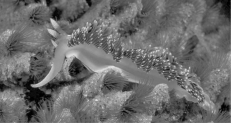Multiple Choice
This nudibranch, a type of sea slug, has many reddish cerata on its dorsal surface, as well as two, white-tipped rhinophores located on the head.

The nontaxonomic term sea slug encompasses a wide variety of marine gastropods. One feature they share as adults is the lack of a shell. We might think, therefore, that they represent defenseless morsels for predators. In fact, sea slugs have multiple defenses. Some sea slugs prey on sponges and concentrate sponge toxins in their tissues. Others feed on cnidarians, digesting everything except the nematocysts, which they then transfer to their own skins. Whereas the most brightly colored sea slugs are often highly toxic, others are nontoxic and mimic the coloration of the toxic species. Their colors are mostly derived from pigments in their prey. There are also sea slugs that use their coloration to blend into their environments.
-Sea slugs can obtain nematocysts by preying on sea
A) anemones.
B) urchins.
C) daisies.
D) cucumbers.
E) lilies.
Correct Answer:

Verified
Correct Answer:
Verified
Q66: A stalked, sessile marine organism has several
Q67: Which clade in the phylum Cnidaria includes
Q68: Planarians lack dedicated respiratory and circulatory systems
Q69: Which of the following combinations of phylum
Q70: Among the invertebrate phyla, phylum Arthropoda is
Q72: An elementary school science teacher decided to
Q73: The sea slug, Pteraeolidia ianthina, can harbor
Q74: The crown-of-thorns sea star, Acanthaster planci, preys
Q75: How many of the following can be
Q76: A farm pond, usually dry during winter,